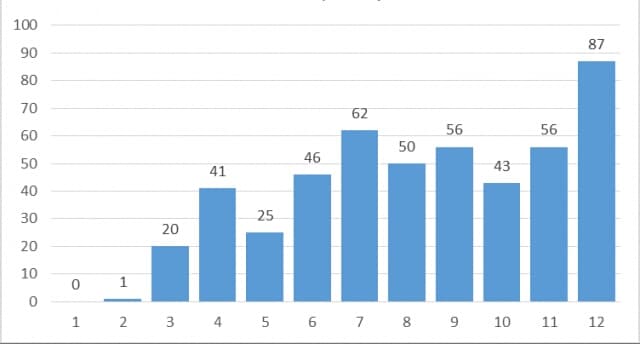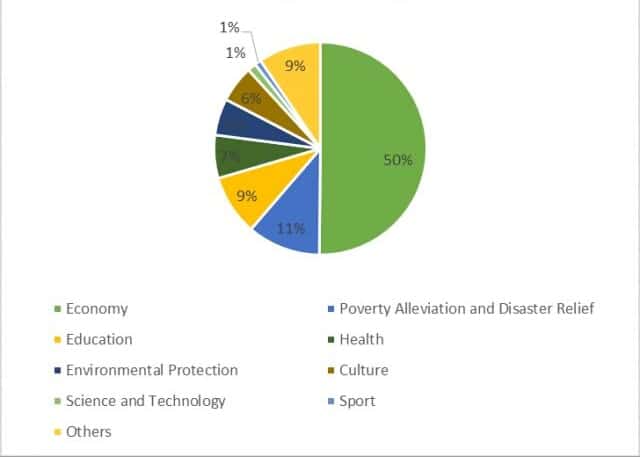Editor’s Note
This article was originally published by the Office of Overseas NGOs of the Ministry of Public Security, and translated into English by CDB. Some parts have been cut out from our translation. You can find the original here.
1. National and regional distribution
By the 31st of December 2017, 305 overseas non-governmental organizations (ONGOs) had registered their representative offices in China. The United States, Hong Kong, Japan, South Korea and Germany are home to 71.48% of these overseas organizations.
| No. | Countries/Regions | Number of Registered Organizations |
| 1 | United States | 72 |
| 2 | Hong Kong | 60 |
| 3 | Japan | 42 |
| 4 | Korea | 24 |
| 5 | Germany | 20 |
| 6 | United Kingdom | 13 |
| 7 | Taiwan | 11 |
| 8 | Switzerland | 10 |
| 9 | Canada | 9 |
| 10 | France | 9 |
| 11 | Netherlands | 6 |
| 12 | Macao | 4 |
| 13 | Australia | 4 |
| 14 | Italy | 2 |
| 15 | Malaysia | 2 |
| 16 | Belgium | 2 |
| 17 | India | 2 |
| 18 | Brazil | 2 |
| 19 | Singapore | 1 |
| 20 | Spain | 1 |
| 21 | Turkey | 1 |
| 22 | Mongolia | 1 |
| 23 | Russia | 1 |
| 24 | Denmark | 1 |
| 25 | United Arab Emirates | 1 |
| 26 | New Zealand | 1 |
| 27 | Madagascar | 1 |
| 28 | Croatia | 1 |
| 29 | Thailand | 1 |
| Total | 305 |
 The headquarters of the ONGOs are widely distributed all over the world. Most of them are located in North America (26.56%), Hong Kong, Macao & Taiwan (24.59%), Northeast Asia (21.64%) and Europe (21.64%).
The headquarters of the ONGOs are widely distributed all over the world. Most of them are located in North America (26.56%), Hong Kong, Macao & Taiwan (24.59%), Northeast Asia (21.64%) and Europe (21.64%).

| No. | Area | Number of Registered Organizations |
| 1 |
North America |
81 |
| 2 | Hong Kong, Macao & Taiwan | 75 |
| 3 | Northeast Asia | 66 |
| 4 | Europe | 66 |
| 5 | Others | 17 |
| Total | 305 |
2. Place of registration
Out of the 305 organizations, 74.43% of them registered their representative offices in Beijing, Shanghai, Yunnan, Guangdong and Liaoning.
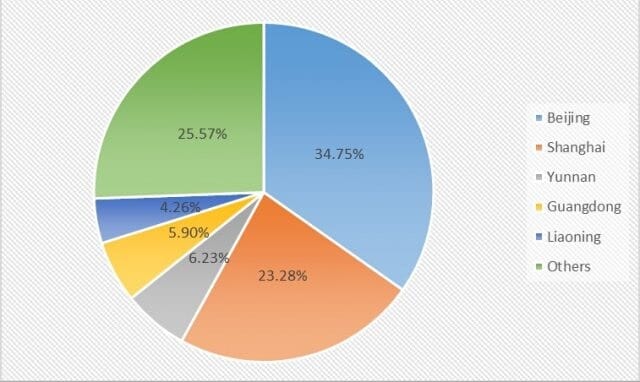
| No. | Place of Registration | Number of Registered Organizations |
| 1 | Beijing | 106 |
| 2 | Shanghai | 71 |
| 3 | Yunnan | 19 |
| 4 | Guangdong | 18 |
| 5 | Liaoning | 13 |
| 6 | Sichuan | 12 |
| 7 | Tianjin | 8 |
| 8 | Shandong | 8 |
| 9 | Fujian | 7 |
| 10 | Guangxi | 5 |
| 11 | Jiangsu | 5 |
| 12 | Gansu | 4 |
| 13 | Shaanxi | 4 |
| 14 | Hubei | 4 |
| 15 | Chongqing | 4 |
| 16 | Hunan | 4 |
| 17 | Heilongjiang | 2 |
| 18 | Zhejiang | 2 |
| 19 | Henan | 2 |
| 20 | Jiangxi | 1 |
| 21 | Xizang | 1 |
| 22 | Inner Mongolia | 1 |
| 23 | Guizhou | 1 |
| 24 | Jilin | 1 |
| 25 | Qinghai | 1 |
| 26 | Anhui | 1 |
| Total | 305 |

3. The professional supervisory units of the ONGOs
(1) Overview
Out of the different branches of the Chinese administrative system, the five branches with the most PSUs are the departments (部门) of Commerce, Civil Affairs, Health and Family Planning, and Education, and the people’s organizations (人民团体, a form of government-run civic association). These five branches account for the PSUs in charge of 76.07% of the 305 ONGOs that registered.
| No. | PSU | Number of Registered Organizations |
| 1 | Commerce | 138 |
| 2 | Civil Affairs | 30 |
| 3 | Heath and Family Planning | 23 |
| 4 | Education | 23 |
| 5 | People’s organizations | 18 |
| 6 | Forestry | 10 |
| 7 | Press, Publication, Radio Film and Television | 9 |
| 8 | Foreign Affairs and Overseas Chinese Affairs | 7 |
| 9 | Environmental Protection | 6 |
| 10 | Poverty Alleviation | 5 |
| 11 | Agriculture | 5 |
| 12 | Development and Reform | 5 |
| 13 | Grain | 4 |
| 14 | Sport | 3 |
| 15 | Science and Technology | 3 |
| 16 | Culture | 2 |
| 17 | Economy and Information Technology | 2 |
| 18 | Tourism | 2 |
| 19 | Transport | 2 |
| 20 | Others | 8 |
| Total | 305 |

(2) Ministerial level PSUs
75 out of 305, or 24.59%, of the ONGOs have ministerial-level PSUs. The remaining 230 ONGOs are supervised by provincial authorities. The top five PSUs at the ministerial level are the Chinese People’s Association for Friendship with Foreign Countries, the Ministry of Civil Affairs, the State Administration of Press, Publication, Radio, Film and Television, the State Forestry Administration and the National Health and Family Planning Commission, accounting for 57.33% of all ONGOs with ministerial-level PSUs.
| No. | PSU | Number of Registered ONGOs | Ratio of Ministerial-level PSUs |
| 1 | Chinese People’s Association for Friendship with Foreign Countries | 12 | 92.31% |
| 2 | Ministry of Civil Affairs | 11 | 36.67% |
| 3 | The State Administration of Press, Publication, Radio, Film and Television | 8 | 88.89% |
| 4 | The State Administration of Forestry | 7 | 70.00% |
| 5 | National Health and Family Planning Commission | 5 | 21.74% |
| 6 | Ministry of Education | 5 | 21.74% |
| 7 | Overseas Chinese Affairs Office of the State Council | 5 | 83.33% |
| 8 | Ministry of Environmental Protection | 5 | 83.33% |
| 9 | State Administration of Grain | 4 | 100.00% |
| 10 | National Development and Reform Commission | 3 | 60.00% |
| 11 | General Administration of Sport | 2 | 66.67% |
| 12 | State Ethnic Affairs Commission | 1 | 100.00% |
| 13 | Ministry of Land and Resources | 1 | 100.00% |
| 14 | Chinese Association of International Understanding | 1 | 100.00% |
| 15 | China National Tourism Administration | 1 | 50.00% |
| 16 | China Disabled Person’s Federation | 1 | 33.33% |
| 17 | State Post Bureau | 1 | 100.00% |
| 18 | National Energy Administration | 1 | 100.00% |
| 19 | Ministry of Housing and Urban-Rural Development | 1 | 100.00% |
| Total | 75 |
(3) 15 new PSUs appeared over the second half of the year
There are currently 32 administrative branches that include PSUs for ONGOs in China. The departments of commerce and civil affairs and the Health and Family Planning Commission are the most deeply involved departments. 138 ONGOs are supervised by PSUs belonging to the department of commerce. When it comes to the supervision of organizations involved in charity-like activities, then the department of civil affairs, the Health and Family Planning Commission, the department of education and the Chinese People’s Association for Friendship with Foreign Countries are the most active branches of the government, taking charge of 30, 23, 23, and 13 organizations respectively. The PSUs became more diverse in the second half of the year, with PSUs from 15 new branches including the Disabled Person’s Federation, the Economy and Information Technology Commission and the departments of culture, tourism, transport, housing and urban-rural development.
Other than that the Chinese People’s Association for Friendship with Foreign Countries, the Chinese Association for International Understanding, the State Ethnic Affairs Commission, the Ministry of Land and Resources, the Shanghai Institute for International Studies and the Shanghai’s Youth League were also added to the list of PSUs.
4. Fields of work of the registered ONGOs
Looking at the areas in which the 305 organizations work, the five most common areas are the economy, poverty alleviation and disaster relief, education, health and environmental protection, taking up 82.62% of the total.
| No. | Field of Work | Numbers of Registered Organizations |
| 1 | Economy | 153 |
| 2 | Poverty Alleviation and Disaster Relief | 34 |
| 3 | Education | 28 |
| 4 | Health | 20 |
| 5 | Environmental Protection | 17 |
| 6 | Culture | 17 |
| 7 | Science and Technology | 4 |
| 8 | Sport | 3 |
| 9 | Others | 29 |
| Total | 305 |
5. Location of activities of the representative offices
108 (35.41%) organizations have activities in the whole of China, while the others cover one or more provinces. So far, 93 of the 305 ONGOs only have activities in the province where they are located, while 212 (69.51%) cover more than one province.
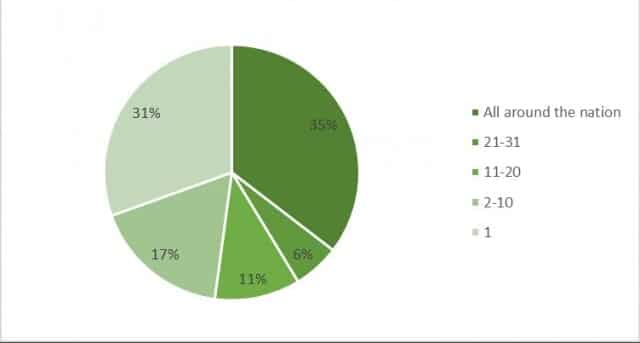
| No. | Number of Areas Covered | Number of Registered Organizations | Ratio |
| 1 | National | 108 | 35.41% |
| 2 | 21-31 | 18 | 5.90% |
| 3 | 11-20 | 33 | 10.82% |
| 4 | 2-10 | 53 | 17.38% |
| 5 | 1 | 93 | 30.49% |
| Total | 305 | 100.00% |
The 108 organizations whose activities radiate all over China are mainly registered in Beijing and Shanghai. Specifically, 55 (50.95%) registered in Beijing and 40 (37.04%) in Shanghai, together making up 87.96% of the 108 organizations.
6. ONGOs which set up more than one regional representative organization
So far, 259 ONGOs have established 305 representative offices in China. 27 own more than one representative office. The China-Britain Business Council and World Vision rank at the top of the list with six representative offices each.
7. National and regional distribution of ONGOs which have filed temporary activities in Mainland China
By December 31st 2017, there had been 487 temporary activities filed in Mainland China. 90.14% of the activities were filed by organizations from Hong Kong, the U.S, Germany, Taiwan and South Korea.
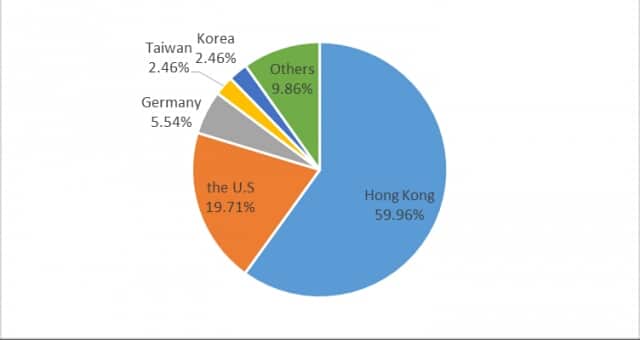
| No. | Country/Region | Number of Registered Temporary Activities |
| 1 | Hong Kong | 292 |
| 2 | United States | 96 |
| 3 | Germany | 27 |
| 4 | Taiwan | 12 |
| 5 | Korea | 12 |
| 6 | Japan | 9 |
| 7 | Macao | 8 |
| 8 | UK | 8 |
| 9 | Switzerland | 4 |
| 10 | Netherland | 3 |
| 11 | Sweden | 3 |
| 12 | Australia | 2 |
| 13 | Canada | 2 |
| 14 | France | 2 |
| 15 | United Arab Emirates | 1 |
| 16 | Sri Lanka | 1 |
| 17 | The Philippines | 1 |
| 18 | Malaysia | 1 |
| 19 | Italy | 1 |
| 20 | Singapore | 1 |
| 21 | Kuwait | 1 |
| Total | 487 |
The figures above show that most of the temporary activities (64.07%) were filed by organizations from Hong Kong, Macao and Taiwan. 98 (20.12%) activities were filed by North American organizations.
8. Location of the Temporary Activities
59.55% of the 487 filed activities were situated in Beijing, Guangdong, Sichuan, Yunnan and Guizhou.
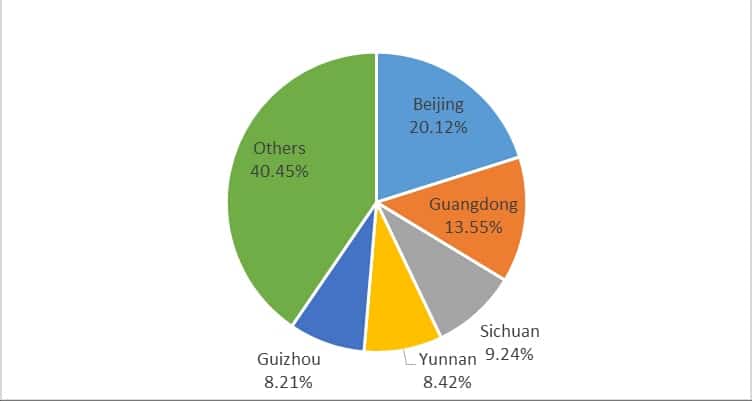
| No. | Place of Registration | Number of Registered Organizations |
| 1 | Beijing | 98 |
| 2 | Guangdong | 66 |
| 3 | Sichuan | 45 |
| 4 | Yunnan | 41 |
| 5 | Guizhou | 40 |
| 6 | Shaanxi | 24 |
| 7 | Gansu | 23 |
| 8 | Chongqing | 23 |
| 9 | Zhejiang | 16 |
| 10 | Guangxi | 14 |
| 11 | Shanghai | 14 |
| 12 | Hunan | 13 |
| 13 | Qinghai | 13 |
| 14 | Henan | 10 |
| 15 | Inner Mongolia | 7 |
| 16 | Hubei | 7 |
| 17 | Anhui | 7 |
| 18 | Ningxia | 5 |
| 19 | Jiangsu | 5 |
| 20 | Liaoning | 3 |
| 21 | Hebei | 2 |
| 22 | Jiangxi | 2 |
| 23 | Heilongjiang | 2 |
| 24 | Fujian | 1 |
| 25 | Xinjiang | 1 |
| 26 | Hainan | 1 |
| 27 | Tianjin | 1 |
| 28 | Jilin | 1 |
| 29 | Tibet | 1 |
| 30 | Shandong | 1 |
| Total | 487 |
9. ONGOs with more than one temporary activity
The 487 temporary activities were held by 230 ONGOs. 59 organizations organized more than one activity, contributing to 316 activities in total, 64.89% of the total.
10. Registration of representative offices and temporary activities by month
The average number of ONGO registrations by moth was 25. The month of May witnessed the highest number with 48.
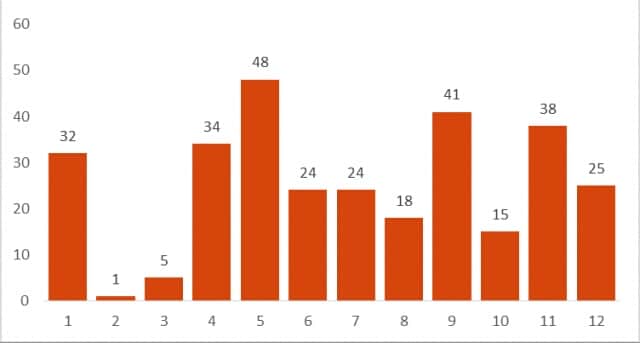
Overall the record for temporary activities shows an upward trend, peaking in December with 87.
